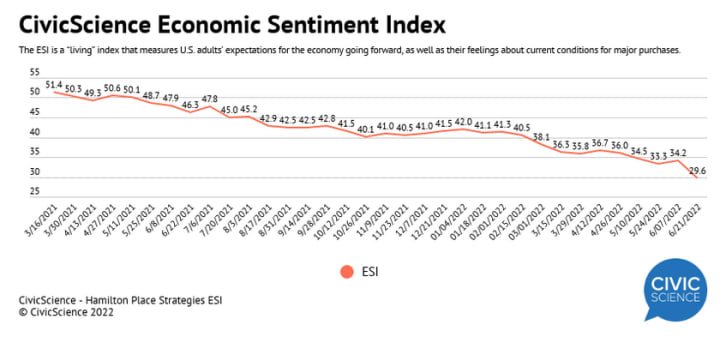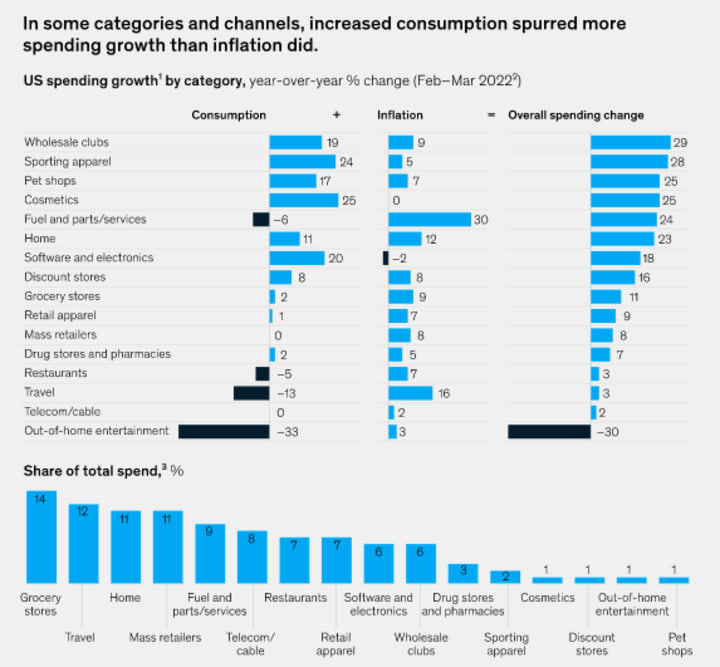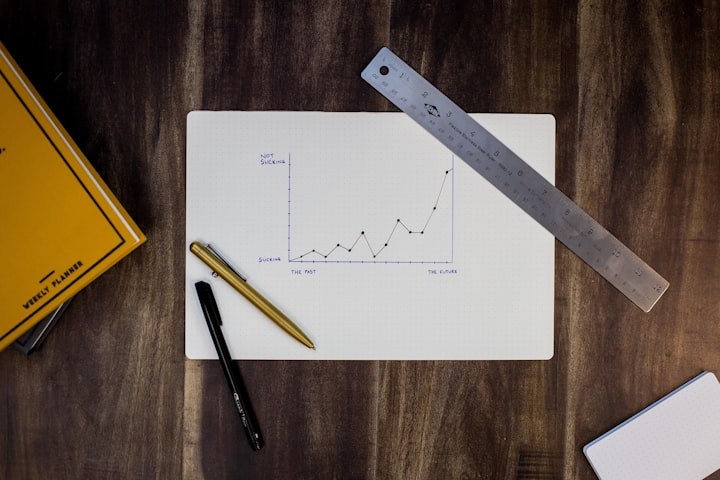With Inflation, Consumers Are Switching Where They Shop and What They Are Shopping for with One Goal in Mind: Saving Money
Recent consumer spending research shows that shoppers today are reacting to inflation that many have not seen in their lifetimes to emphasize trying to maximize their spending power by switching brands and switching their shopping habits like never before.

Overview
Ask anyone today - a family member, a friend, a coworker, or just a random person on the street - what their biggest worry is today and they will most likely say one thing: Inflation. Everywhere we go in our daily lives where we spend money, from gas stations to restaurants to yes, the grocery store, we are today spending more of it - on everything! And yes, we are feeling it - and acting upon it - as we go about our daily lives. According to the most recent economic data from the Bureau of Labor Statistics, the inflation rate in the U.S. (as measured by the Consumer Price Index [CPI]) is up 8.6% year-over-year (see Figure 1: Inflation in the United States, June 2022), reaching the highest point in the current round of inflation, the likes of which have not been seen - or experienced - by Americans since the early 1980’s! This means that many adults today have not had to deal with significant price inflation ever before, leading to the present economic circumstances being far more stressful to them because it is, in reality, unprecedented for them!
Figure 1 - Inflation in the United States, June 2022

Source: Trading Economics, United States Inflation Rate, June 2022 (Used with Permission)
As all of us pay more and more - for everything - today, inflation is taking its toll on the mood of American consumers. As can be seen in Figure 2 (CivicScience: Concern Over Inflation in the U.S.), more than nine out of every ten Americans today say that they are concerned about inflation, which is the highest level seen over the past year. And while inflation rates are soaring all over the world, as pent up demand from the pandemic meets with supply chain challenges and the effects of the war in Ukraine to cause a global rise in prices, the fact of the matter is not making U.S. consumers feel any better about their present situations.
Figure 2 - CivicScience: Concern Over Inflation in the U.S.
Source: CivicScience, As Americans Feel the Weight of Inflation, Where Are They Placing Blame?, June 2022, (Used with Permission)
At the root of the souring American mood is the reality that we are indeed expecting to pay more for everything today, with groceries leading the way by far (see Figure 3 - CivicScience: U.S. Consumer Expectations for Rising Prices by Spending Category, June 2022)! The economics of our personal
Figure 3 - CivicScience: U.S. Consumer Expectations for Rising Prices by Spending Category, June 2022
Source: CivicScience, As Americans Feel the Weight of Inflation, Where Are They Placing Blame?, June 2022, (Used with Permission)
balance sheets are taking a hit as a result, as today, Americans are increasingly expecting to have less money in their pockets six months from now than they do today (see Figure 4 - CivicScience: U.S. Consumer Expectations for Six Months from Now, June 2022)!
Figure 4 - CivicScience: U.S. Consumer Expectations for Six Months from Now, June 2022
Source: CivicScience, As Americans Feel the Weight of Inflation, Where Are They Placing Blame?, June 2022, (Used with Permission)
And so while today’s inflation is indeed a global phenomenon and, in relative terms, not unprecedented or even worse than at times in the past, the present economic situation is making Americans far more pessimistic about their personal finances. And yes, this is impacting not just how we shop, which we will focus on in this article, but how we generally feel today. As Figure 5 (CivicScience Economic Sentiment Index, May 2021-June 2022) shows, Americans' economic sentiment has dropped sharply throughout the first half of 2022, reaching the lowest level since 2013! And with not just inflation worries, but with fears of a likely recession and with the uncertainty over extremely volatile asset prices today (witness the recent stock market correction and the perhaps “topping out” of the real estate market), it perhaps is a wonder that Americans’ economic sentiment isn’t even worse than it presently is!
Figure 5 - CivicScience Economic Sentiment Index, May 2021-June 2022

Source: CivicScience, Economic Sentiment Falls Sharply, Following Downturn on Wall Street, June 2022, (Used with Permission)
And so inflationary pressures are today influencing consumer behavior in two primary ways when it comes to shopping for food - something that yes, all of us need! As we will see in this article, recent research shows that rising prices are changing both not just how much, but what consumers are buying in terms of food items and where they are shopping for their groceries. And for food marketers and retailers who rely on sales of grocery items, all of this is not just having an impact today, but the impact of the present inflation-shaped shopping patterns will likely have long standing implications in the years to come. Thus, it is vital for all in the grocery industry - and beyond - to be aware of the two important trends in consumer food shopping that are being formed today. And this is the purpose of the present article.
Trend 1: Inflation is Impacting the Foods We Are Buying
The big news today is that not only are Americans buying less food due to inflation, as in many cases, consumers are shifting what they are buying. And this shift in shopping habits is moving beyond the obvious. Consumers today are increasingly shifting to lower cuts of beef (and even buying the “clearance” [near the expiration date] packages of meat) and substituting dark meat chicken for the higher priced chicken breasts (or buying whole chickens instead of parts) - even moving to plant-based and dairy options for protein - are indeed doing today. As shown in Figure 6 (eMarketer: What Grocery Products Are U.S. Consumers Cutting Back on Due to Inflation), drawn from consumer spending research from the data analyst firm, eMarketer, shoppers today are cutting back on buying entire categories of food - and drink (including alcoholic beverages!). However, the thing consumers in this survey mentioned buying less of due to rising prices is not a specific category of food, but rather name brands, with 41% of Americans saying that this is the case for them.
Figure 6 - eMarketer: What Grocery Products Are U.S. Consumers Cutting Back on Due to Inflation

Source: eMarketer, Brand Values Fail to Entice Inflation-worried Consumers, June 2022, (Used with Permission)
Now, the eMarketer team thought that the main message of their findings in regards to customers cutting back their spending on name brand food products was one of messaging. In other words, with consumers being worried about inflation and shifting to a more price-conscious mindset, they advised that advertising today should emphasize value, rather than being aspirational or promoting a brand's social consciousness. While not a grocery product per se, eMarketer specifically cited how in today’s environment, an ad campaign such as Chipotle’s “Can a Burrito Change the World?” underperforms with consumers as it seems out-of-touch with what is front of mind - namely price and value - today. They concluded that today, we are in an environment where Americans value “value over values (and a) commitment to brand ethos and purpose is taking a back seat as consumers prioritize lower prices.”
A more in-depth study on consumer shopping behaviors in the current environment was recently published by the global management consulting firm, McKinsey & Company. The McKinsey research (“How US Consumers Are Feeling, Shopping, and Spending—And What It Means for Companies”) echoed eMarketer’s findings that American shoppers are becoming more price conscious based on today’s inflationary pressures and that brands would be wise to message on this basis. And yet, the McKinsey report emphasized that brands overall are today under great pressure, as consumers are very willing to “trade down” and switch to a lower priced brand. They are today even more willing than ever to try private label brands - particularly store brands for grocery products like Great Value at Walmart and Kirkland Signature at Costco. And this trend away from well-known, higher priced brands to store brands today goes well beyond the food aisles. Target, for instance, offers a total of 45 private label brands in its stores and online!
The McKinsey study showed that not only are Americans today fast-changing what they buy in terms of food products, but changing where they buy it. As can be seen in Figure 7 (McKinsey: U.S. Shoppers Switching Brands and Retailers, 2020-2022), the “switch rate” is far higher today than it was before the pandemic. And even more importantly for all involved in food marketing and retailing, 9 out of 10 Americans do not plan for their shift in their shopping patterns to be a temporary “fix” during today’s inflationary period. Rather, they (well, “we”) anticipate that the changes they are making today will become part of their shopping habits in the future. This makes what the changes we are seeing today in consumer behavior not a “blip,” but an important second trend that will shape grocery retailing for years to come.
Figure 7 - McKinsey: U.S. Shoppers Switching Brands and Retailers, 2020-2022

Source: McKinsey & Company, How US Consumers Are Feeling, Shopping, and Spending—And What It Means for Companies, May 2022, (Used with Permission)
Trend 2: Inflation is Changing Where We Are Shopping for Food
The McKinsey study revealed an important shift in the “where” of how we are buying food products today. This is the unmistakable rise of non-grocery outlets in the food marketplace. Figure 8 (McKinsey: U.S. Retail Spending, Year-Over-Year Changes in Spending [2022 vs. 2021] and Spending Across Categories of Retailers [2022]) below shows first the year-over-year changes in total consumer spending at various retail outlets in the United States, along with the total share of spending broken down across various categories of retailers.
Figure 8 - McKinsey: U.S. Retail Spending, Year-Over-Year Changes in Spending (2022 vs. 2021) and Spending Across Categories of Retailers (2022)

Source: McKinsey & Company, How US Consumers Are Feeling, Shopping, and Spending—And What It Means for Companies, May 2022, (Used with Permission)
As you can see, the McKinsey researchers broke down spending growth in each category of the retail world by taking out the growth in spending accounted for by inflation and separating that out from the growth in spending caused by, well, simply more consumers spending more (or less) money in each category of retailers. This enables one to see the “net” increase (or decrease) in consumer spending at each type of retail outlet. Overall, McKinsey found that with inflationary pressures, spending on goods is up, while spending on out of home services (dining out, traveling, and entertainment) is down significantly year-over-year.
However, consumer spending seems to be shifting - markedly - in terms of food products. While grocery stores still command the leading share of total consumer spending at 14%, other retail outlets where food products are a major share of their product offerings are seeing significant growth that grocery stores are not. As can be seen in Figure 8, total spending at grocery stores grew by 11% year-over-year from early 2021 to early 2022. However, the McKinsey researchers determined that inflation accounted for the bulk of that increase (9% out of the 11% aggregate increase in spending). This meant that consumer demand only increased grocery store expenditures by 2% year-over-year. Contrast that finding with what was found in regards to the growth of two major categories of retailers - wholesale clubs and discount retailers - where food makes up an important part of their marketing mix.
First, wholesale clubs, such as Costco, Sam’s Club, and B.J.’s Wholesale Club, saw the highest growth of any retail category in consumer spending year-over-year at 28% (see Figure 8)! It is quite significant that the majority of this increase (19%) can be attributed to a true increase in shopping activity at wholesale clubs, with only 9% owing to price inflation. This is quite understandable, as American consumers, whole today are seeking value to a much greater extent than they were prior to both the pandemic and the recent surge in inflation, are flocking to wholesale clubs in record numbers - and buying more food at them, rather than at traditional grocery stores. A recent analysis showed that shoppers’ instincts that they could save by shifting more of their food buying to these wholesale clubs is indeed, to borrow a phrase, on the money, as grocery store prices were found to be up over 14% from May 2021 to May 2022, while food prices at wholesale clubs rose by just half that amount! With the opportunity to buy in bulk at these outlets and save in the process, wholesale clubs appear to be particularly well positioned to thrive over the next few years with Americans seeking to stretch their buying power, especially when it comes to feeding their families!
Discount retailers have also seen significant consumer spending growth, rising by 16% year-over-year according to the McKinsey analysis (see Figure 8). This increase was equally attributable to actual growth in consumption (8%) and to inflation (also 8%). Discount grocery chains, such as Aldi and even Trader Joe’s, have fared particularly well as Americans have become much more value conscious with the rise in inflation. But beyond discount grocery, discount stores, such as Dollar General, Family Dollar, and Dollar Tree, who have all added more and more grocery items to their stores, appear to be particularly well positioned to appeal to shoppers seeking value today. Quite interestingly, mass retailers, such as Walmart and Target, who have grown to become massive presences in the food market with their superstores with grocery offerings to rival - or even outpace - many grocery stores themselves, have not seen such growth over the past year. In fact, the McKinsey research showed that while the mass retail category grew by 8% year-over-year, all of that 8% increase was driven by inflation, not increased consumer consumption! This should be extremely worrisome to top executives in Bentonville (Walmart) and Minneapolis (Target) alike, as their massive chains appear to not be “winning” the hearts and minds - and dollars - of consumers today in the way wholesale clubs and discount retailers are when it comes to not just food shopping, but shopping in general!
Finally, the real exception to the trend of Americans shopping more and more for food at alternative outlets, rather than at grocery stores, appears to be drugstores. National drugstore chains, most notably Walgreens and CVS, have become important food sources for many Americans, especially in urban and suburban areas, and grocery items have become a staple of these chains' operations. The McKinsey research showed that rather than experiencing dramatic gains year-over-year as was seen with wholesale clubs and discount stores, drugstores fell into the same pattern as grocery stores in terms of consumer spending growth. As can be seen in Figure 8, while overall drugstore spending grew by 7% year-over-year, the majority of that increase (5%) was attributed to inflation, with only a 2% net growth in consumer spending at these retailers. And with grocery items making up a smaller portion of total sales at drugstores than what would be found in either wholesale clubs or discount stores, this would indicate that Americans are not seeing drugstores as a retail outlet offering value to them at a time where shoppers are increasingly price conscious. Thus, while drugstores have been building up their food offerings in store to expand their value proposition to consumers, they might face significant headwinds in the near-term marketing to price conscious shoppers.

Analysis
These twin - and interrelated trends - will have a tremendous impact not just on retailing today, but well into the future. As the McKinsey analysts stressed, not only are American consumers changing what they buy food wise and where they shop for grocery items today, “most of them say they intend to incorporate that behavior into their routines.” And so what we are dealing with in terms of seeing movement away from name brand products toward private label brands and shoppers shifting more and more of their grocery buying away from grocery stores per se are not short-term trends. Rather, the inflation-coping we see going on today will go a long way in shaping the future of retailing. Thus, retail executives and food marketers alike should pay heed to these two trends, as they are game changers in terms of not just the way we shop for food, but where we will buy grocery items in the years to come. And in particular, executives of grocery store chains, from the giants like Kroger and Publix to those local chains and small, independent grocers that do remain, should seriously examine what they are presently doing on a number of fronts, from advertising and marketing to sourcing and store layouts, to examine how they can reverse what should be a very concerning trend to them, namely that grocery stores are fast becoming not the first choice for many Americans when it comes to grocery shopping!
++++++++++++++++++++++++++++++++++++++++++++++++++++
About David Wyld
David Wyld is a Professor of Strategic Management at Southeastern Louisiana University in Hammond, Louisiana. He is a management consultant, researcher/writer, publisher, executive educator, and experienced expert witness. You can view all of his work at https://authory.com/DavidWyld.
Social Media Links to David Wyld:
About the Creator
David Wyld
Professor, Consultant, Doer. Founder/Publisher of The IDEA Publishing (http://www.theideapublishing.com/) & Modern Business Press (http://www.modernbusinesspress.com)






Comments
There are no comments for this story
Be the first to respond and start the conversation.